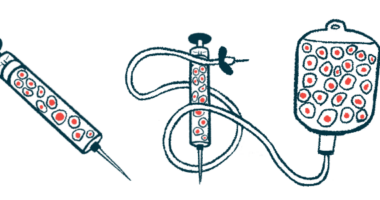Blood test for PRKN activity may be early-onset Parkinson’s screen
Neurons lacking gene show mitochondrial defects, lysosomal dysfunction

Mutations in the PRKN gene, a common cause of early-onset Parkinson’s disease, were tied directly to low activity of the gene, a study reports.
Because gene activity was measured by standard methods using cells in the bloodstream, the findings may support developing an “easily accessible screening test for PRKN mutations,” the researchers wrote in “Parkin mRNA Expression Levels in Peripheral Blood Mononuclear Cells in Parkin-Related Parkinson’s Disease,” which was published in Movement Disorders.
Parkinson’s is marked by the death of dopaminergic neurons, cells in the brain that make the neurotransmitter dopamine. The loss of dopamine-making cells disrupts nerve signaling, which ultimately gives rise to Parkinson’s symptoms.
The PRKN, or PARK2, gene carries instructions to make parkin, an enzyme that chemically tags damaged and excess proteins within mitochondria, the structures in cells that produce energy. Tagged proteins are transported to lysosomes, the cell’s recycling centers, for degradation.
Dopaminergic neurons that lack PRKN, and therefore have no parkin enzyme, show mitochondrial defects and impaired lysosomal function, which likely contributes to cell dysfunction and death in early-onset Parkinson’s.
Whether disease-causing mutations directly influence the activity of the PRKN gene itself prompted a research team led by scientists at the Biomedical Research Foundation of the Academy of Athens, Greece, to measure the activity of PRKN in peripheral blood mononuclear cells (PBMCs) from patients and healthy people.
Assessing PRKN activity
Easily accessible from the bloodstream, PBMCs have round nuclei and consist mostly of immune lymphocytes — T-cells, B-cells, and NK cells — and some monocytes. PBMCs “are very useful as a first screening test to assess for the presence of PRKN-variants,” the researchers wrote.
PBMCs were collected from 12 patients with PRKN mutations, 21 patients with sporadic Parkinson’s, that is, those without a known disease-related genetic defect, and 21 healthy controls.
Using a standard method called real-time PCR, gene activity was assessed by measuring the levels of PRKN messenger RNA (mRNA), the intermediate molecule that carries the genetic instructions to make the parkin enzyme. Lower mRNA levels reflect reduced gene activity and lower parkin production.
Six patients carried heterozygous PRKN mutations, meaning one of the two genes they inherited from each parent was defective. Two had homozygous mutations, with the same defect in both inherited genes, and four were compound heterozygous, two different mutations in each inherited gene. Thus, six patients carried one PRKN mutation, and six had two mutations.
Despite researchers trying to select lower age controls and sporadic Parkinson’s patients for the study, those carrying PRKN mutations were younger and had a significantly lower age of onset than the other groups. Apart from these differences, the disease duration, the time with symptoms, and the extent of motor symptoms were similar across all the patients.
Experiments revealed significantly lower activity of the PRKN gene among those with either one (heterozygous) or two (homozygous/compound heterozygous) mutations compared with healthy controls and sporadic patients.
PRKN mRNA levels were either undetectable or very low in patients with two mutations and low in those with one mutation, but these differences didn’t reach statistical significance. Controls and sporadic patients had similar mRNA levels.
Most patients with one mutation had an mRNA profile closer to those with two mutations, except two heterozygous patients who had mRNA values in the control range.
Based on the gene activity data, low PRKN mRNA levels predicted the presence of one or two PRKN mutations, with an accuracy of up to 100%.
Mutations without symptoms
The researchers also described two unusual cases whereby the parents of patients carried the same PRKN mutation, but were asymptomatic.
A 22-year-old Parkinson’s patient with a heterozygous PRKN mutation had very low mRNA levels, while his 62-year-old mother with the same mutation hadn’t developed symptoms. Her PRKN mRNA levels were four times higher than her son’s, but were still lower than healthy control levels. His father was not a mutation carrier and had control-range mRNA levels.
Similarly, a man with two compound heterozygous PRKN mutations developed Parkinson’s at age 32 and had almost no detectable mRNA. His father, who was 72, carried one of the two mutations and had mRNA levels in the lower range of healthy controls, but similar to those of affected heterozygous patients.
Researchers suggested that people with one heterozygous PRKN mutation, even when asymptomatic, may have a small degree of dopaminergic neuronal dysfunction. They indicated it was “highly possible that participants in our cohort did not have the necessary compensatory mechanisms, as they have already developed [Parkinson’s disease].”
The study shows that assessing PRKN activity “by the standard method of real time-PRC in PBMCs represents a valid screening tool” to identify PRKN carriers in those with Parkinson’s, the researchers said, noting it would have a wide application, they said.







